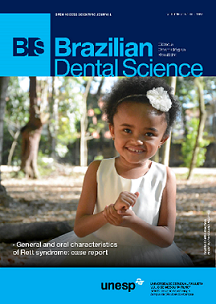Effects of ovariectomy, estrogen and soy isoflavones in rats submandibular glands
DOI:
https://doi.org/10.14295/bds.2017.v20i3.1443Abstract
Objective: A decrease in granular convoluted tubule (GCT) cells and acini occurs in the submandibular glands of castrated female rats, while in rats submitted to hormone replacement and phytotherapy with soy isoflavones, this effect is reversed. This study aimed to elucidate the mechanisms through which these changes occur. Material and Methods: Rats (n=84) were ovariectomized and 21 were sham-operated. Ovariectomized rats were randomly subdivided and orally administered the following: 17 ?-estradiol (OVX-E; n=21), 15 mg/kg/day of soy isoflavone extract (OVX-I; n=21), 17 ?-estradiol + soy isoflavone extract (OVX-A; n=21); and water as placebo (OVX; n=21). The rats were euthanized three, five and eight weeks after ovariectomy. The submandibular salivary glands were submitted to histological processing with HE stain and immunohistochemistry was performed using the streptavidin-biotin-peroxidase complex. The cell area and the expression of proliferating cell nuclear antigen and estrogen receptor ? were evaluated. Results: The results were statistically analyzed by ANOVA and Tukey test. A decrease in the area of GCT cells in the OVX, was observed, in contrast with an increase in the OVX-E. PCNA in the acinar cells and estrogen receptors were elevated in the OVX-I group. Conclusion: Castration exerts an immediate reductive effect on the volume of GCT cells. Estrogens, soy isoflavones and their combination have different mechanisms of action on the homeostasis of the gland. Estrogens cause an increase in GCT cells area, while isoflavones enhance cell proliferation and the expression of estrogen receptor-?. Their association showed no additional increase in the effect studied.
Keywords
Estrogen; Morphometry; Salivary glands; Soy isoflavones.
Downloads
Downloads
Additional Files
Published
How to Cite
Issue
Section
License
Brazilian Dental Science uses the Creative Commons (CC-BY 4.0) license, thus preserving the integrity of articles in an open access environment. The journal allows the author to retain publishing rights without restrictions.
=================




























